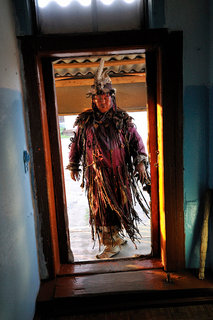After being educated by Siberian shamans for three years, I became the first wolf shaman in Turkey. The Ajalat Shamanic Center is the only place in Turkey where traditional Turkic Shamanism is practiced. My colleague Asu Mansur and I have dedicated ourselves to strengthen and develop the ancient way of shamanism by guiding people to a natural way of being.
In this video, you can see what we do.
You may click the picture to view the video, as well.
The headdress of the traditional Turkic kam is often called a böört, which is pronounced like bird, but with a “t” at the end. The Böört is a very important part of the kam’s equipment. It not only protects the shaman from negative entities called Aza, it also gives the owner a light feeling in the head when it is put on.
The first kams in Turks are women. The cams of the past are the bards of today. Bards and cams go back and forth between the lower world (Erlik-Darkness) and the Upper world-Lightness and expel the evil spirits. It ensures that the light wins goodness. The yin and yang in nature are black and white, it provides the balance between good and evil. In the Efe game of the Turks, it is a cam dance in the form of an eagle. and bravery wins.

The lightness in the head is created by the many feathers, which most often surround the böört. The feathers should be from strong and high-flying birds, like the eagle, crane, or goose.
One eagle feather is necessary because the eagle is a predator who can protect the head of its owner from evil spirits. The feathers also help the shaman fly to other dimensions and the upper world, where the ancestors and gods are. Mostly, it does not matter what is put on the böört, except for the feathers. They must have some protective or strengthening value.
The long ribbons in front of a böört are mainly designed for their protective purposes from evil spirits or evil eyes. Evil eyes can burn you or let you dry out. For example, if you walk through a shopping mall, sit in a crowded area, or a better example: you are with people you do not like so much, your eyes will start to burn or itch. This is a sign that one or more people have burned you with their evil eyes. A good way to protect oneself from this, if you are not a shaman, is to put on mirrored sunglasses. They will reflect the energy back to the owner, because your eyes will not be in contact. The shaman needs these ribbons for the same purpose.
Some shamans put horns to each side of the böört. This has two reasons. One is for threatening reasons and the other one has ancestral significance. The threatening part is again against evil spirits, to push them away like the bull pushes away its attackers.
The ancestral value is dedicated to Oguz Khan, the first Turk in history. The name Oguz means the ones from the space (aliens). From Oguz Khan, all the Turkic tribes came out. Oguz Khan was blueish, had red eyes and a red mouth. His helmet had two long horns at their sides.

That was the time long before Abraham. In respect and knowledge of our forefathers, the shaman wears the böört to carry this legacy from generation to generation. Shamans are also keepers of the truth and true history. Therefore, everything they put on the böört is a truth.


